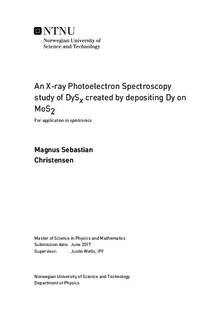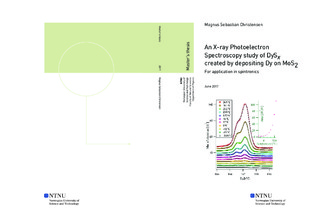| dc.description.abstract | There are many interesting materials under research for spintronics today, including the Transition Metal Dichalcogenides (TMDCs). They are particularly interesting because they collectively host materials which are semiconductors, superconductors and ferromagnets and combinations of these properties are useful for a myriad of spintronic applications. Since MoS2 is a cheap and available semiconducting crystal, and Dy is the most magnetic of all elements, we attempt to create thin films of Dy on a MoS2 substrate to see if we can create a periodic structure, and if so, if we get an interesting combination of the physical properties of MoS2 and Dy.
By X-ray Photoelectron Spectroscopy (XPS), we find a chemical reaction takes place upon deposition of Dy on a -140 °C MoS2 sample, and that subsequent annealing will, given a thick enough Dy layer, cause some DySx compound to move from the MoS2-Dy interface to the Dy surface. The results indicate a S:Dy ratio of 2 when the Dy film is saturated with S.
The crystallinity of the created DySx should be investigated before its electrical and magnetic properties are determined for a thorough consideration of possible application to spintronic devices. | |

